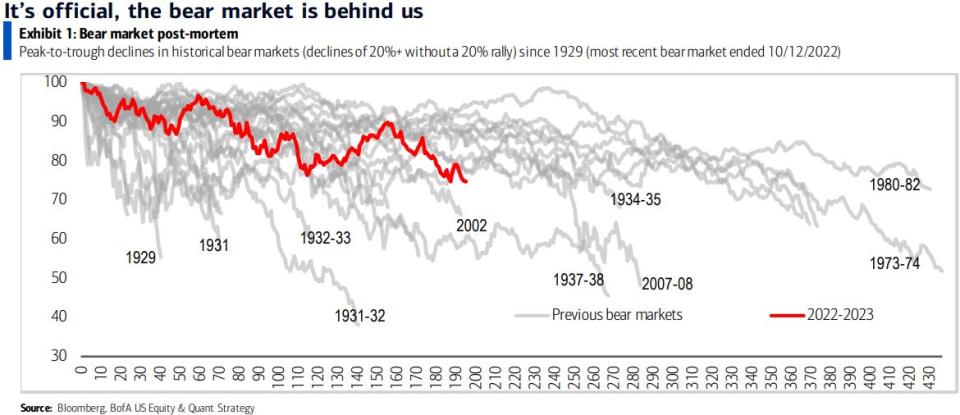'New bull market has legs': These are the 5 questions investors should ask now that the bear market is officially over

There's more upside left in stocks after a new bull market started on Thursday, according to Bank of America.
"After crossing the +20% mark from the bottom, the S&P 500 continued to rise over the next 12 months 92% of the time," BofA said.
These are five questions investors should ask now that the bear market is officially over, according to BofA.
The bear market in stocks is officially over and a new bull regime has begun after theS&P 500 closed 20% above its October 12 closing low on Thursday.
And according to a Friday note from Bank of America's equity strategist Savita Subramanian, the stock market gains could continue as investors slowly buy into the bullish environment and macro headwinds like rising interest rates near their end.
Additionally, stocks do well after the 20% bull market threshold is reached, based on historical data.
"We don't put a lot of stock (pun intended) in arbitrary definitions, but note that after crossing the +20% mark from the bottom, the S&P 500 continued to rise over the next 12 months 92% of the time, returning 19% on average," Subramanian said.
That's based on data since the 1950s and is compared to a 12-month winning ratio of just 75% and an average overall 12-month return of 9%.
While there are still risks to the rally, the stock market has a way of continuing to climb a wall of worry while investors sit on the sidelines due to negative sentiment and lingering worries. But now is the time for investors to get ready for a new bull run and start asking questions to prepare.
These are the five things investors should ask now that the bear market is officially over and a new bull regime has begun, according to BofA.
1. "What will it take to get investors bullish again?"
"The wall of worry could continue until investors feel pain in long bonds or FOMO in equities. Investors have bought into a singular equity theme (AI, more below) but a broader bull case for stocks can be made: we are off of ZIRP and real yields are positive again, volatility around rates and inflation has subsided, earnings uncertainty has declined and companies have preserved margins by cutting costs and focusing on efficiency. After a fast hiking cycle, the Fed has latitude to ease. The equity risk premium could fall from here," Subramanian said.
2. "Should I invest in actively managed funds?"
"After decades of passive equity funds taking share from active, the active approach in public equity now makes sense. Less eyeballs means inefficient markets (more alpha), higher dispersion and a reversal in passive inflows argue for stock picking over indexing. The index primacy this year from record narrowness is unsustainable," Subramanian said.
3. "Which equity index, equal-weighted or cap weighted?"
The equal-weighted S&P 500 could yield double the returns of the S&P 500 index based on various signals. These include breadth reversion, relative value (the equal-weighted index trades at 15x), lower duration risk vs. the cap weighted index and more upside vs. the cap weighted index based on our analysts' price targets," Subramanian said.
4. "If stocks are reviled, why is the S&P 500 trading at 20x?"
"Wall Street is rife with conviction-less bears, and individual investor outflows are at capitulation levels somewhat at odds with high snapshot multiples. 20x is not the reason to be bearish - when earnings fall as they are today, P/E ratios expand. It's just math," Subramanian said.
5. "How can I make money off of AI?"
"The obvious beneficiaries, capex takers, are semis and select software companies that can provide AI services. But not all Tech wins, many need to spend just to remain competitive. The larger benefit may be had by old economy, inefficient companies that can increase earnings power more permanently from efficiency and productivity gains," Subramanian said.

Read the original article on Business Insider

 Yahoo Finance
Yahoo Finance 